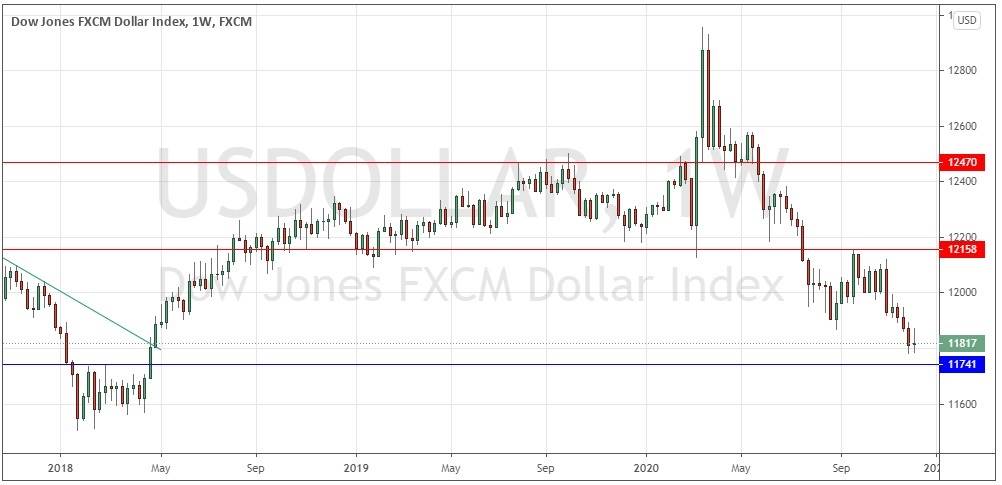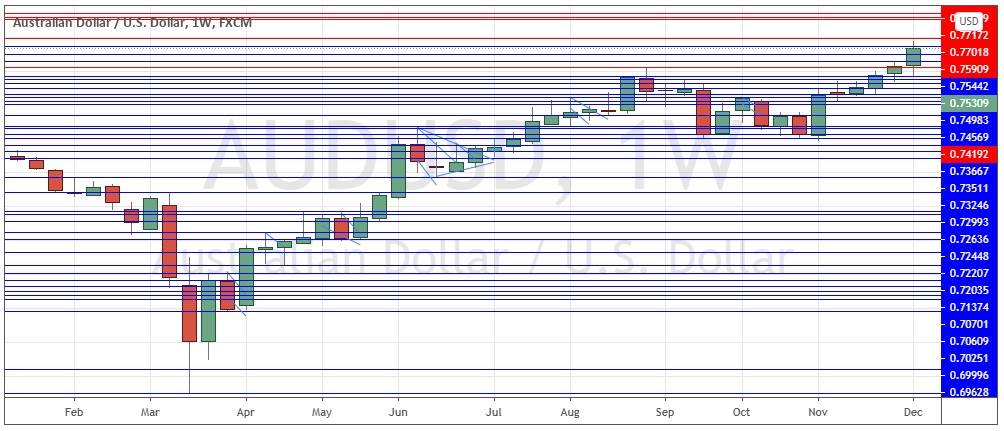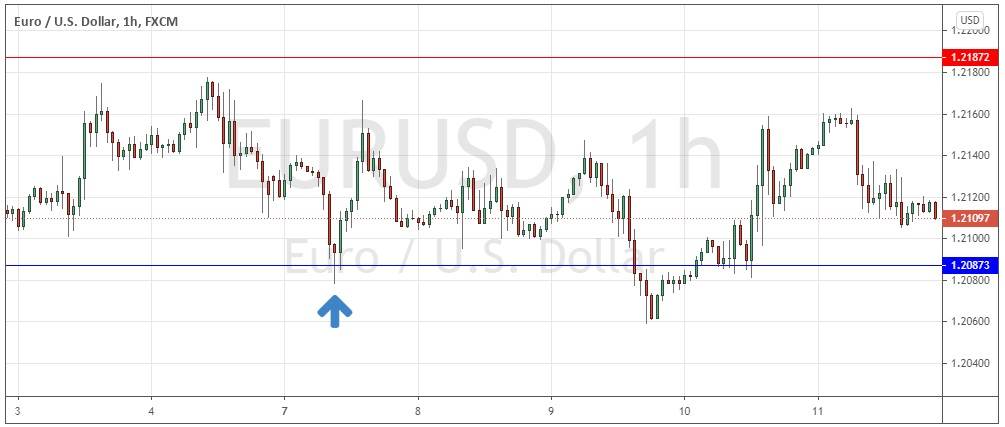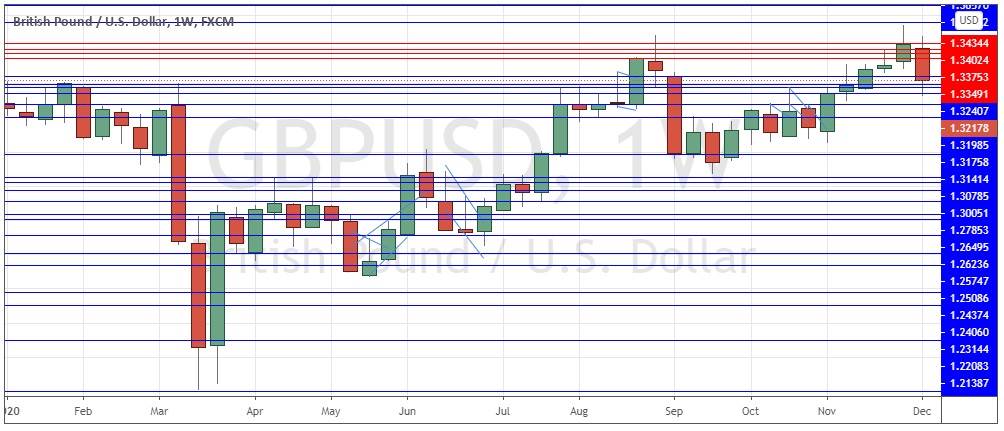When starting the trading week, it is a good idea to look at the big picture of what is developing in the market as a whole and how such developments and affected by macro fundamentals and market sentiment.
It is a great time to be trading markets right now, as there are many valid, strong trends in favor of stocks and riskier assets and against the U.S. dollar.
Big Picture 13th December 2020
In my previous piece last week, I saw the most attractive trade opportunities as likely to be long of the EUR/USD currency pair and of the S&P 500 Index. This was not such a great a great call, as the EUR/USD currency pair closed on Friday down by 0.09%, while the S&P 500 stock market index fell by 0.85%, so this was an average loss of 0.47%.
Last week’s Forex market saw the strongest rise in the relative value of the Australian dollar and the strongest fall in the relative value of the British pound. There is still a strong trend against the U.S. dollar, meaning it is an attractive time to be trading Forex, as the greenback is the prime driver of the Forex market.
Fundamental Analysis & Market Sentiment
The headline takeaway is that we are seeing a continuing positive trend in stock markets and in riskier currencies such as the commodity currencies (CAD, AUD, NZD) as well as the euro, and a strongly negative trend in the U.S. dollar, although we have had a slight pullback over the past week. We have seen an unusually strong negative move in the British pound as a final “no-deal” Brexit looks likely to happen at the end of 2020 in the absence of an agreed trade deal. We have also recently seen stock market indices make new all-time highs (S&P 500, Nikkei 225, KOSPI). Risk-on sentiment is quite firm, with the prospect of effective mass vaccinations against coronavirus in view.
Last week saw a moderate increase in the level of volatility in the Forex market, due mainly to strong price movement in the British pound and the Australian dollar because of Brexit and the Aussie being a key market barometer of risk sentiment. Although there was a key central bank release from the ECB, it contained no surprises and had little impact on prices.
The latest news on E.U./U.K. talks remains pessimistic regarding the prospect of a deal, which would be negative for the British pound if true.
Global stock markets are somewhat less bullish, with major indices trading off their recent highs.
This week is likely to see a lot of activity in the Forex market as central bank releases are due from the Federal Reserve, the Bank of Japan, the Bank of England, and the Swiss National Bank. Wednesday’s FOMC federal funds rate, statement, and economic projection release is likely to be the most important event of the week in the Forex market.
Last week’s major story in the U.S. has been a continuing strong increase in new daily confirmed coronavirus cases, with new hospitalizations and deaths also continuing to rise strongly. Several states have announced new lockdowns and other restrictions in an attempt to stem the spread of the virus. One piece of good news: the Pfizer vaccine has been approved for use in the U.S.A. Vaccinations in the U.K. have already begun and will begin in more countries over the coming days and weeks.
Last Friday saw an all-time record number of new daily cases confirmed globally, at 704,570, and last Thursday saw an all-time high in global daily coronavirus deaths, at 12,918. The European Union is reporting more deaths than the U.S. but has seen a fall in both deaths and new cases, while the U.S. is seeing strong increases in both.
The strongest growth in new confirmed cases is happening in Albania, Argentina, Armenia, Azerbaijan, Belarus, Belize, Bosnia, Brazil, Bulgaria, Burkina Faso, Croatia, Cuba, Czech Republic, Denmark, Dominican Republic, Egypt, Estonia, Finland, Germany, Guatemala, Honduras, Indonesia, Israel, Jamaica, Japan, South Korea, Latvia, Lithuania, Mexico, Netherlands, Nigeria, Norway, Panama, Paraguay, Poland, Russia, Senegal, Serbia, Slovakia, Slovenia, South Africa, Sudan, Turkey, the Ukraine, Uruguay, U.K., and the U.S.A.
Technical Analysis
U.S. Dollar Index
The weekly price chart below shows that the U.S. Dollar index printed a bearish-looking inside doji candlestick last week. It closed within the lower half of its price range, which is a bearish sign. Although there is a strong bearish trend, the support level shown not far from the price at 11471 may stop much more downwards movement happening over the short term. Overall, next week’s price movement in the U.S. dollar looks somewhat likely to be downwards. This is a relatively good time to be trading the U.S. dollar short, so I am focusing only on trades which are short of the U.S. dollar.
AUD/USD
The AUD/USD currency pair again closed Friday at a 2.5-year weekly high closing price, which is a bullish sign. The candlestick closed near the top of its price range, and the week’s range was quite large, suggesting the price is likely to rise further over the coming week. A further bullish sign is that the price has cleared the major psychological level and round number at 0.7500.
EUR/USD
The EUR/USD currency pair made a small bearish retracement last week, printing an indecisive doji candlestick after hitting new 2.5-year high prices last week. There is a strong, long-term bullish trend which suggests that bullish movement is likely to resume, but to be safe it is probably best to wait for a daily close above 1.2150 before taking any new long trade position.
GBP/USD
The GBP/USD currency pair fell sharply last week on increased volatility within a long-term bullish trend. This means it may rise strong next week as a reversion to the mean of the trend, although this is only likely to happen if there is positive news or rumor about the chance of a U.K./E.U. trade deal bring reached.
Bottom Line
I see the best likely opportunities in the financial markets this week as long of the EUR/USD currency pair following a daily (New York) close above 1.2150 and long of the AUD/USD currency pair following a daily close above 0.7533.




